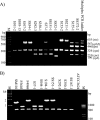Prevalence of enterotoxigenic Clostridium perfringens Isolates in Pittsburgh (Pennsylvania) area soils and home kitchens
- PMID: 17905877
- PMCID: PMC2168196
- DOI: 10.1128/AEM.01075-07
Prevalence of enterotoxigenic Clostridium perfringens Isolates in Pittsburgh (Pennsylvania) area soils and home kitchens
Abstract
In the United States and Europe, food poisoning due to Clostridium perfringens type A is predominantly caused by C. perfringens isolates carrying a chromosomal enterotoxin gene (cpe). Neither the reservoir for these isolates nor the point in the food chain where these bacteria contaminate foods is currently understood. Therefore, the current study investigated whether type A isolates carrying a chromosomal cpe gene are present in two potential reservoirs, i.e., soil and home kitchen surfaces. No C. perfringens isolates were recovered from home kitchen surfaces, but most surveyed soil samples contained C. perfringens. The recovered soil isolates were predominantly type A, but some type C, D, and E soil isolates were also identified. All cpe-positive isolates recovered from soil were genotyped as type A, with their cpe genes on cpe plasmids rather than the chromosome. However, two cpe-positive soil isolates did not carry a classical cpe plasmid. Both of those atypical cpe-positive soil isolates were sporulation capable yet failed to produce C. perfringens enterotoxin, possibly because of differences in their upstream promoter regions. Collectively these results suggest that neither soil nor home kitchen surfaces represent major reservoirs for type A isolates with chromosomal cpe that cause food poisoning, although soil does appear to be a reservoir for cpe-positive isolates causing non-food-borne gastrointestinal diseases.
Figures



References
-
- Cornillot, E., B. Saint-Joanis, G. Daube, S. Katayama, P. E. Granum, B. Carnard, and S. T. Cole. 1995. The enterotoxin gene (cpe) of Clostridium perfringens can be chromosomal or plasmid-borne. Mol. Microbiol. 15:639-647. - PubMed
-
- Fisher, D. J., K. Miyamoto, B. Harrision, S. Akimoto, M. R. Sarker, and B. A. McClane. 2005. Association of beta2 toxin production with Clostridium perfringens type A human gastrointestinal disease isolates carrying a plasmid enterotoxin gene. Mol. Microbiol. 56:747-762. - PubMed
Publication types
MeSH terms
Substances
LinkOut - more resources
Full Text Sources
Molecular Biology Databases
Research Materials
Miscellaneous

